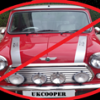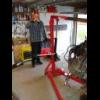Almost certainly a burnt out exhaust valve.
No Compression On One Cylinder
#16

Posted 25 March 2017 - 06:08 PM
#17

Posted 25 March 2017 - 06:10 PM
I'll take the head off tomorrow. I'd rather it be a valve than a piston :)
#18

Posted 25 March 2017 - 06:13 PM
When you take the head off don't forget to check it with a straight edge (even if it turns out to be a valve) especially between the middle two cylinders.I'll take the head off tomorrow. I'd rather it be a valve than a piston :)
#19

Posted 25 March 2017 - 07:34 PM
I've burnt out an exhaust valve on a 998 in the past, this was on long motorway trip. Mixture was fine at idle, it was at higher speed that it leaned out.
Good news was that only the valve was burnt, exhaust seat was fine (this was before seat inserts were used).
So if your problem is a burnt valve it may be a relatively quick fix.
#20

Posted 25 March 2017 - 08:39 PM
Back in the early days of Minis burnt exhaust valves were a very common problem.
I remember a friend of my wife said that her Mini was not going well. It wouldn't run properly and it had a top speed of about 50 mph. She took it to a local garage who said it needed a complete new engine.
My wife said to bring it round on Saturday morning and I would take a look. I took the plugs out and did a rough compression test. It had no compression on no.3.
I asked if she could spare a couple of hours, took the head off, stripped out the damaged valve, fitted a second-hand one I happened to have which was OK. Lapped all the valves in, re-fitted the head, adjusted the mixture and re-set the static timing. It was soon running again and I suggested she drove it up the road to see if it felt better. She came back with a big smile and said it had never gone that well before. Then she asked how much she owed me. I said that if she wanted to buy me a beer we would be straight. She came back with a bottle of Johnny Walker!
So a burnt valve is a quick & simple job.
#21

Posted 25 March 2017 - 09:12 PM
Back in the early days of Minis burnt exhaust valves were a very common problem.
I remember a friend of my wife said that her Mini was not going well. It wouldn't run properly and it had a top speed of about 50 mph. She took it to a local garage who said it needed a complete new engine.
My wife said to bring it round on Saturday morning and I would take a look. I took the plugs out and did a rough compression test. It had no compression on no.3.
I asked if she could spare a couple of hours, took the head off, stripped out the damaged valve, fitted a second-hand one I happened to have which was OK. Lapped all the valves in, re-fitted the head, adjusted the mixture and re-set the static timing. It was soon running again and I suggested she drove it up the road to see if it felt better. She came back with a big smile and said it had never gone that well before. Then she asked how much she owed me. I said that if she wanted to buy me a beer we would be straight. She came back with a bottle of Johnny Walker!
So a burnt valve is a quick & simple job.
I'll bring it round in the morning ![]()
Can the head gasket be re-used if the head's been off?
Edited by PaulColeman, 25 March 2017 - 09:14 PM.
#22

Posted 25 March 2017 - 09:29 PM
No, a new head gasket and, if removed, manifold gasket, must always be fitted after the head is removed.
You need a good basic tool kit including a set of feeler gauges to re-set the valve clearances (0.012" cold), a torque wrench with a 9/16" socket, and some valve grinding paste. You will probably need at least one valve and, if doing the job properly, a full set of exhaust valves.
If one or more valve seats is damaged it/they will need lightly re-facing by a machine shop, then the valve(s) re-lapping.
It's a straightforward job and even a newbie can do it in a morning. Get a Haynes Manual first.
#23

Posted 26 March 2017 - 05:29 PM
Thanks all for the replies.
I took the head off today and found a broken valve as a few had suggested. As far as I'm concerned that's better than a holed piston and the bore is not scored to I'm assuming the broken bit of the valve got ejected pretty quickly, so I think we got away lightly.
However, I'm not sure what to order as I don't know if it's the inlet or exhaust valve. Perhaps somebody could tell me please?

Thanks, Paul.
#24

Posted 26 March 2017 - 05:41 PM
Exhaust valve.
#25

Posted 26 March 2017 - 06:35 PM
Paul,
I think the exhaust valve for a 1976 998cc is AEA434, as described on Minispares website 'Early Large cotter groove exhaust valve.Most small-bore engines seem particularly prone to burning valves, it is highly recommended to replace the exhaust valves when you do a valve job! This 1.0" valve fits most early 948cc, 998cc and 1098cc engines.'
Link: http://minispares.co...ies/AEA434.aspx
But before ordering take out the burnt exhaust valve and check that the collet groove at the end of the valve looks same type (later ones used smaller collet groove, and are not easily interchangeable).
All of the exhaust valves in your head are white, this is often a sign of lean mixture. Running correct mixture at idle is no guarantee of it being right at wider throttle openings. When ordering a new valve I would recommend getting a replacement AUC4387 red spring from Minispares for the SU carb, this will help. You may also need to change needle to get correct mixture, but would try a new red spring first.
Link: http://minispares.co...es/AUC4387.aspx
Edited by carbon, 26 March 2017 - 06:37 PM.
#26

Posted 26 March 2017 - 06:46 PM
im a smart ass and keep a spare head /gaskets what i can spend time and love on off the car and just swop it when needs be.cars not of the road long then
#27

Posted 26 March 2017 - 06:55 PM
Hopefully the seat is not damaged when you whip that badboy out. At least it confirms our suspicions and not the end of the world.
#28

Posted 26 March 2017 - 07:24 PM
Thanks for the clarification/suggestions. I will pull the valve tomorrow to double check before I order anything and hope the seat is still okay (fingers crossed). Maybe it will make the London to Brighton yet...
Cheers, Paul.
#29

Posted 26 March 2017 - 07:56 PM
The seat will need grinding (lapping) to exactly match the new valve anyway. Whether it needs recutting with a tool is another matter. You will need a valve grinding tool (sucker on a stick) and a pack of grinding paste. Used to be a little double-ended tin, coarse one end, fine the other, but last time I saw it they were in two cheap plastic pots.
It is not usual to need the coarse paste, but on this occasion I would suggest starting with it. A little bit on the seat, stick between palms of hands, sucker on head of valve, shuffle hands back and forth 20 times to rotate it, lift and turn a quarter turn, repeat. The valve should remain against the seat due to its own weight, no need to press down. After about 10 cycles of that, take valve out, wipe clean and examine carefully. If you have got a continuous dull grey ring on both valve and head, proceed to the fine paste and do the same. If not, and it looks that you will get there, continue till you do. If not, it is a recutting job, so take it to an engine reconditioners or buy the correct tool, whichever makes most economic sense.
It goes without saying that al trace of abrasive must be utterly removed before assembling the engine! I usually wash the valve in petrol, then apply some detergent (washing-up liquid is ok) and run it under the tap for a while, before drying and lightly oiling to prevent flash rusting.I wash the entire head, if possible, and if not, the affected port, in petrol and pay particular attention to the guides, where I pull several fresh disposable cloths through, the last one being fresh each time. That way I know I have done my best. Professionals in a well-equipped workshop may have other methods, but I doubt that a quick blow with compressed air would suffice. Good for removing metallic debris after machining, but possibly not for sticky abrasive. But is someone can improve on the cleaning process, please feel free to contribute.
You used to, and perhaps still do, get valve lapping attachments for an electric or cordless drill. The best of these produce an oscillatory action as you do by hand, which is quite important. Rotating continuously in one direction is bad. I never had much success with mine, keeping the sucker on the valve., and inevitably went back to using the stick. A spot of glycerine on the sucker (and on any suckers for things like satnav mounts) helps form a seal and does not harm the rubber as grease would. I have used glycerine-based cough medicine when I could not get the right stuff. The valve head needs to be bright, clean metal to make it work. Old valves clean up nicely with a rotary wire brush, but perhaps not the twisted knot variety much loved by body restorers, which are somewhat aggressive. A cheap thing from B&Q will do. Eye protection essential!
#30

Posted 26 March 2017 - 08:21 PM
Thanks for the tips :) I will check the seat once the valve's out and go from there.
Cheers, Paul.
1 user(s) are reading this topic
0 members, 1 guests, 0 anonymous users

















